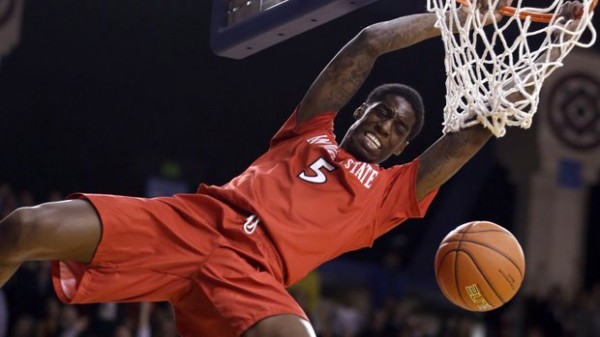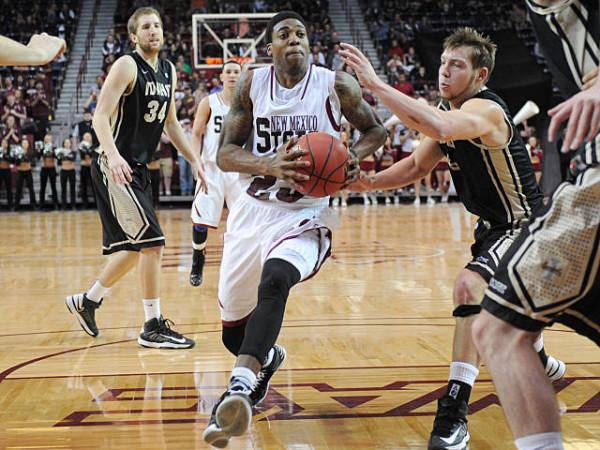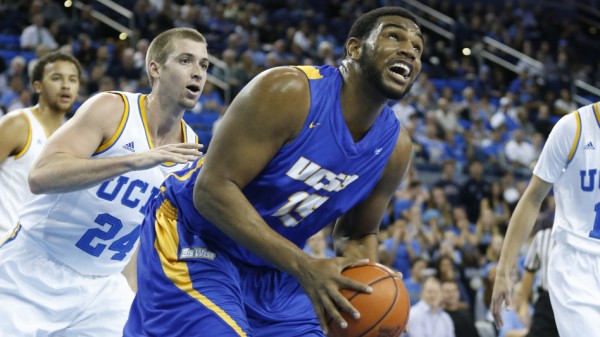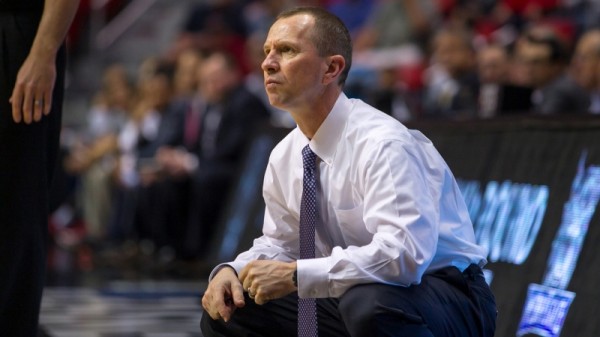Top of the O26 Class: Big Sky, Big West, Mountain West, WAC & WCC
Posted by Tommy Lemoine on November 10th, 2014Leading up to the season, this microsite will preview the best of the Other 26 conferences, region by region. In this installment, we examine the leagues that have a traditional footprint in the Western region of the U.S: Big Sky, Big West, Mountain West, Western Athletic Conference, West Coast Conference. Previous installments include conferences from the Northeast region, Midwest region, Mid-Atlantic/Southeastern region and the Southern region.
Top Units
Mountain West

Guys like wing Dwayne Polee II will need to step up offensively for San Diego State. (Ben Margot/AP)
- San Diego State – 2013-14 record: 31-5 (16-2). San Diego State will be very good defensively, that much we know, but whether it can replace do-everything guard Xavier Thames (17.6 PPG, 120.0 ORtg) is the most pressing concern this time around. The Aztecs – which have ranked among the top-20 nationally in defensive efficiency in three of the last four seasons – return several long-armed stoppers like Dwayne Polee II and 6’10’’ center Skyler Spencer (best block percentage in the league) while adding a highly-touted Arizona transfer in 6’9’’ Angelo Chol. But Thames was the only consistent offensive threat last year and points were hard to come by when he struggled, so the ability of guys like Polee and guard Winston Shepard to thrive in more prominent scoring roles is crucial. Steve Fisher’s club should win the Mountain West considering the talent he has on hand (five-star forward Malik Pope also joins the mix), but the team’s offensive development, especially in the backcourt, will determine its ultimate national stature.
- Boise State – 2013-14 record: 21-13 (9-9). The Broncos have the conference’s premier scoring duo in wing Anthony Drmic and guard Derrick Marks, each of whom Sports Illustrated projects to be among the nation’s top 50 scorers this season. Throw in senior Mikey Thompson (8.6 PPG) and this backcourt should be awesome, but replacing big man Ryan Watkins could be an issue. The 6’9’’ center was the country’s top offensive rebounder last season (19.9% OR), averaged a double-double and served as the team’s defensive centerpiece. With Watkins now gone, Leon Rice turns to 6’7’’ sophomore Nick Duncan and several newcomers in the frontcourt. If they can just play adequate basketball, the guards should do enough to keep Boise State in the NCAA Tournament discussion.
West Coast Conference
- Gonzaga – 2013-14 record: 29-7 (15-3). Gonzaga has legitimate Final Four potential. Of course, prognostications only mean so much in November, but when you look at the Bulldogs’ roster – loaded with experienced returnees and talented newcomers – it’s no wonder they are ranked no. 13 in the preseason AP poll and favored to run away with the WCC. The backcourt boasts a pair of four-year starters, Gary Bell and Kevin Pangos, who combined for 25.0 PPG a year ago, along with returning contributor Kyle Dranginis (6.1 PPG) and four-star freshman Josh Perkins. The frontcourt, already anchored by 7’1’’ center Przemek Karnowski, welcomes Kentucky transfer Kyle Wiltjer and USC transfer Byron Wesley, who led the Trojans last season with 17.8 PPG. But wait, there’s more – Mark Few also added European freshman Domantas Sabonis, the 6’10’’ son of NBA legend Arvydas Sabonis. That combination of talent, depth and experience could mean special things this season in Spokane.
- BYU – 2013-14 record: 23-12 (13-5). The Cougars lose forward Eric Mika (11.8 PPG, 6.4 RPG) to an LDS mission and Matt Carlino to transfer, but WCC Player of the Year Tyler Haws is back along with versatile forward Kyle Collinsworth, who was injured with a torn ACL in last year’s conference tournament. Haws (23.2 PPG) is poised to break Jimmer Fredette’s school scoring record this season and should keep Dave Rose’s up-tempo offense rolling, but the play of frontcourt guys like 6’11’ center Nate Austin and forward Josh Sharp – in the absence of Mika – will dictate BYU’s ceiling. The recent injury to UNLV transfer Jamal Aytes does not help matters. Still, the Cougars should be an NCAA Tournament-caliber unit again this season.
- Saint Mary’s – 2013-14 record: 23-13 (11-7). Three starters depart, including the Gaels’ top scorer last season, but efficient big man Brad Waldow (15.7 PPG, 7.5 RPG) is back along with a trio of talented incoming transfers. Guards Aaron Bright (Stanford) and Joe Coleman (Minnesota) and forward Desmond Simmons (Washington) were each solid contributors at their respective high-major schools before heading to Moraga. If the Gaels can piece it all together, they have the tools to compete with BYU for second place in the conference.
Big Sky
- Weber State – 2013-14 record: 19-12 (14-6). The defending Big Sky champs are favorites to win the league again, but not without a few question marks. Chief among them: How do the Wildcats replace Big Sky Player of the Year Davion Berry, who averaged 19.2 PPG last year? Both he and second-leading scorer Kyle Tresnak graduated, so head coach Randy Rahe must turn elsewhere for offensive production. Luckily, junior guard Jeremy Senglin (40.4% 3FG) and a couple talented JuCo transfers should fill some of the void left by Berry in the backcourt, while 6’9’’ forward Joel Bolomboy – a dominant rebounder on both ends of the floor (ranking seventh and eighth nationally in OReb% and DReb% last season) – leads a frontcourt with enough pieces to overcome Tresnak’s departure. Weber State remains the Big Sky’s team to beat.
Big West
- UC Irvine – 2013-14 record: 23-12 (13-2). Four starters are back from last year’s Big West championship unit, including college basketball’s tallest player, Mamadou Ndiaye. The 7’6’’ Senegalese-born center, who boasted the fourth-best block rate in the nation last season, is rejoined down low by rock-solid senior Will Davis II (11.0 PPG, 6.4 RPG) and a pair of 6’10″ guys in what’s sure to be a daunting frontcourt. The Anteaters lose guard Chris McNealy and his 11.0 PPG, but sophomore Luke Nelson – whose style of play Fran Fraschilla has compared to Stephen Curry’s – might be even better after leading the team in scoring as a freshman. Alan Williams and UC Santa Barbara are not far behind, but Russell Turner’s group is our pick to win the league. UC Irvine’s next step? Reaching the NCAA Tournament for the first time in school history.
WAC

Daniel Mullings should pace New Mexico State to another WAC title. (nmstatesports.com / Tim Barnett-Queen)
- New Mexico State – 2013-14 record: 26-10 (12-4). Despite failing to win the regular season title last year, New Mexico State was far and away the WAC’s best team; no one could match its depth and talent, especially when it mattered most. That has not changed entering 2014-15. KenPom slots the Aggies at #79 in his preseason rankings, a whopping 131 spots higher than the next-best conference unit, Seattle. Why the massive disparity? Even without K.C. Ross-Miller (who transferred to Auburn) and 7’5’’ anchor Sim Bhullar (who went pro), NMSU returns a slew of talent, including WAC Player of the Year Daniel Mullings, and athletic forward “Chili” Nephawe. Add another Bhullar to the mix – Tanveer, Sim’s 7’3’’ brother – and the Aggies should reach a fourth straight NCAA Tournament.
Top Players
- Alan Williams – UC Santa Barbara. He’s big, he’s skilled and his statistical dominance has been well-documented. But let’s dig into the numbers anyway: Last year, Williams ranked among the top 50 nationally in offensive and defensive rebounding percentage, block rate and fouls drawn per 40 minutes, while averaging 21.3 PPG on 53 percent shooting. That’s why he is arguably the best mid-major post player in America.
- Tyler Haws – Brigham Young. The 6’5’’ senior is an offensive machine (23.2 PPG), poised to break numerous school records and possibly lead the country in scoring. Unlike most other high-scoring guards and wings, Haws does not rely too heavily on three-pointers, instead utilizing his diverse mid-range game and quick release to rack up points from everywhere on the floor. He’s a joy to watch.
- Larry Nance Jr. – Wyoming. The son of a former NBA All-Star, Nance was having a stellar campaign last season before tearing his ACL in February. Now cleared for action, there’s no reason to think the 6’8’’ forward won’t be even better this year. Look for Nance to improve on his already-impressive numbers (15.4 PPG, 8.6 RPG, 2.1 BPG) and keep Wyoming competitive atop the Mountain West.
- Kevin Pangos – Gonzaga. Pangos is a premier guard and an excellent perimeter scorer, having never shot below 40 percent from behind the arc in his career. After dealing with foot ailments for most of last season, the now-healthy senior might have his most productive season yet – which is saying a lot, considering he’s been a member of the all-WCC team for three years running.
- Tyler Harvey – Eastern Washington. Harvey exploded on the scene last season, leading the Big Sky in scoring (21.8 PPG) and shooting 43.3 percent from behind the arc – 10th best among players who attempted at least 200 triples. He’s a 6’4’’ shooting guard with a well-rounded offensive skill set, and his notoriety will only increase this year as Eastern Washington competes for a conference title.
- Daniel Mullings – New Mexico State. Like Pangos, Mullings is from Canada and plays point guard. Unlike Pangos, Mullings relies more on his athleticism and ability to penetrate than he does his outside shooting. Since he’s also an excellent defender, passer and rebounder for his position (4.9 RPG), another WAC Player of the Year honor is probably in the cards.
High-Flyers
- Jaron Nash – North Dakota. With Troy Huff no longer on the roster, Nash will be a relied-upon veteran for North Dakota after being granted a sixth year of eligibility. Whether he can lead the team remains to be seen, but there’s a very good chance he throws down more monster jams.
- Mark Tollefsen – San Francisco. Sometimes, taller guys look less impressive when they dunk. That, however, is not the case with Tollefsen, who at 6’9’’ – with great hands and tremendous leaping ability – is as aesthetically impressive as any dunker out west. He will be an important player on one of the WCC’s better teams.
- Daniel Mullings – New Mexico State. One other thing about Mullings: He’s an exceptional dunker. He dunks on WAC opponents, he dunks on China – he dunks on everyone.
Coach on the Rise
- Randy Rahe – Weber State. It seems odd that we don’t hear Rahe’s name mentioned more often, considering all the guy does is win games. Since taking over at Weber State in 2006, the former Utah assistant has won four conference titles, amassed five 20-win seasons, made seven postseason tournaments – including the NCAAs twice – and never finished below third in the Big Sky standings. In 2012-13, the Wildcats won 30 games and reached the CIT finals; last year, they fought hard against top-seeded Arizona in the Round of 64. Montana’s Wayne Tinkle recently took the Oregon State job after reaching similar heights in Missoula, so it seems only a matter a time before Rahe gets his shot with a power program (assuming he wants it). With Weber State in great position to win another Big Sky title, that opportunity might come sooner than later.











































